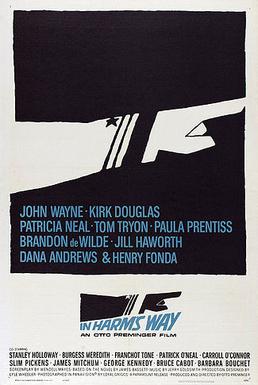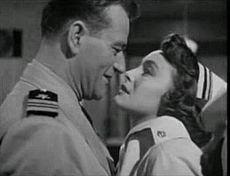In Harm's Way facts for kids
Quick facts for kids In Harm's Way |
|
|---|---|

Theatrical release poster
by Saul Bass |
|
| Directed by | Otto Preminger |
| Produced by | Otto Preminger |
| Screenplay by | Wendell Mayes |
| Starring | John Wayne Kirk Douglas Henry Fonda Patricia Neal |
| Music by | Jerry Goldsmith |
| Cinematography | Loyal Griggs |
| Editing by | George Tomasini Hugh S. Fowler |
| Distributed by | Paramount Pictures |
| Release date(s) | April 6, 1965 |
| Running time | 165 minutes |
| Country | United States |
| Language | English |
| Money made | $4,500,000 (US/Canada rentals) |
In Harm's Way is an exciting American war movie from 1965. It was directed by Otto Preminger. The film stars famous actors like John Wayne, Kirk Douglas, and Patricia Neal. Paramount Pictures distributed the movie.
The story begins just as the United States enters World War II. It follows the lives of several U.S. Navy officers stationed in Hawaii. The movie's title comes from a quote by a brave American naval commander, John Paul Jones. He once said, "I wish to have no connection with any ship that does not sail fast, for I intend to go in harm's way." This means he wanted to be where the action was, even if it was dangerous.
The film shows a realistic view of the American Navy and its officers. It covers the period from December 6, 1941, through the first year of the U.S. involvement in World War II.
Main Characters of the Film
The movie features many characters, showing different roles in the Navy during wartime. Here are some of the main actors and their characters:
- John Wayne plays Captain Rockwell W. "Rock" Torrey. He later becomes a Rear Admiral.
- Kirk Douglas is Commander Paul Eddington. He also gets promoted to Captain.
- Patricia Neal plays Lieutenant Maggie Haines. She is a nurse in the Navy.
- Tom Tryon acts as Lieutenant William "Mac" McConnell.
- Paula Prentiss plays Beverly McConnell.
- Brandon deWilde is Ensign Jeremiah Torrey.
- Jill Haworth plays Ensign Annalee Dorne, another Navy nurse.
- Dana Andrews is Vice Admiral B. T. "Blackjack" Broderick.
- Stanley Holloway plays Clayton Canfil, an Australian coast watcher.
- Burgess Meredith is Commander Egan T. Powell.
- Franchot Tone plays the Commander-in-Chief Pacific (CINCPAC) during the Pearl Harbor attack.
- Henry Fonda appears as a later CINCPAC, based on Admiral Chester W. Nimitz.
How the Movie Was Made
The film was shot in black-and-white by Loyal Griggs. He used a wide-screen Panavision format. Griggs was even nominated for an Academy Award for his amazing camera work. The music for the film was created by Jerry Goldsmith. Also, the opening credit sequence, designed by Saul Bass, is very unique. It actually appears at the very end of the movie!
The filmmakers received a lot of help from the United States Department of Defense. This included the U.S. Navy and the U.S. Marine Corps. Much of the filming happened on real warships at sea. They also filmed at Naval Station Pearl Harbor and Marine Corps Air Station Kaneohe Bay in Hawaii.
One challenge during filming was finding ships that looked like they did in World War II. Most active Navy ships in the 1960s looked very different. Only a few older ships, like the USS Saint Paul and USS Philip, still looked like their wartime versions. Modern equipment on other destroyers had to be covered up to look like old gun-mounts.
Awards and Recognition
In Harm's Way was recognized for its excellent filmmaking.
- In 1965, the film was nominated for an Academy Award for Best Cinematography (Black-and-White). This was for the work of cinematographer Loyal Griggs.
- Patricia Neal won a BAFTA Film Award in 1966. She received it for Best Foreign Actress for her performance in the movie.
See also
- List of American films of 1965
- John Wayne filmography


